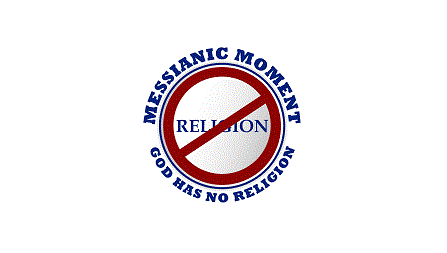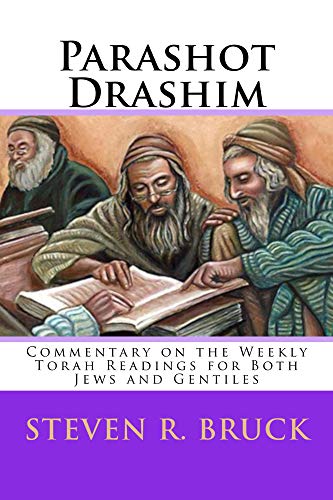You may be thinking that salvation is a gift from God that no one can have taken from them.
And you are right- no one can take our God-given salvation from us, but we can certainly throw it away.
If you prefer to watch a video, click on this link: Watch the video.
We are warned against apostasy, but that isn’t the threat I am talking about.
We are warned about how the Enemy can confuse and mislead us, which is a definite threat, but I don’t believe it is as big as the one I want to tell you about.
The greatest threat to your salvation is…RELIGION!
When we ask God, through Messiah Yeshua, to forgive our sins and take us into his presence, we will be “saved” from the spiritual and eternal consequences of our sins. But that is just the first step: the road leading to that salvation still lays before us and it is a long and treacherous one.
The guide taking us down that road, which almost everyone who worships God in one way or another is led by, is a religion. It may be Judaism, it may be Catholicism; you might be a Protestant or maybe even a Mennonite. There are some 6 sects with Judaism and dozens of Christian religions and sects.
Here is why I say religion is the greatest threat to your salvation: religion is not from God. God tells us exactly what he wants from us regarding how to worship him and how to treat each other, in the Torah. There is no other place, anywhere, in the Bible where God gives us a direct commandment regarding these things.
Religion is the creation of people who want to have power over other people. Religion tells you what you can and cannot do, and also tells you that this is what God really wants. Some religions tell you to ignore the Holy Days that God told us to celebrate, but if you don’t celebrate their man-made holidays, then you will go to hell.
Religions tell you what you want to hear so that their leaders can control you. God has told us all how he wants us to act, but religion tells you it is OK to ignore some of the things God says and do what the religion says you should do. What is worse is that they say it’s OK to ignore the Torah commandments because you believe in Jesus!
For the record, Yeshua (Jesus) NEVER told anyone to do anything other than what his father, God, said to do! And religion tells us that Yeshua is our savior, but that is wrong! We can have our sins forgiven through Yeshua’s sacrifice, but he is NOT our savior- God is.
We are saved because of what Yeshua did but it is God who is our savior because he is the one who forgives us!
Yeshua replaced the need to bring an animal to the temple in Jerusalem, which was the way we used to be forgiven under the sacrificial system. God would forgive our sins by means of the shed innocent blood of the sacrifice, but did anyone ever say that the goat or the bull or the lamb was their savior? Of course not- the sacrifice is not the savior, it is the thing which makes forgiveness possible, and that forgiveness is what saves us, and that forgiveness comes from GOD!
And let’s not forget that it was God who provided the Messiah in the first place!
Religions also attract people, especially today’s Mega-churches, by appealing to their comfort zone. Religion is the greatest threat to your salvation, and next in line after that is your comfort zone.
People love to hear that if they are a good person and believe in Jesus, they will be saved and get to go to heaven.
Anyone who really knows the Bible should immediately realize both of those statements are wrong. First off, no one is good- even Yeshua refused to be called “good” when someone addressed him that way, rebuking them and telling them that only God is good (Mark 10:18). And Revelation 21 tells us that there will be a new heaven and a new earth, so if everyone goes to heaven, why do we need a new earth?
The answer is that no one goes to heaven- that is where God and the angelic beings live. We live on earth. And we can confirm that from the prophecy of Micah, in Micah 4:4 where he says in the Acharit-Hayamim (End Days, meaning after the Messiah has come and is ruling the world) that each man will sit under his own fig tree and drink wine from his own vineyard without fear. Not in heaven, but here on earth (well, the new earth).
Religion teaches you what is OK with God based on what that religions’ originator believed (and NO- Yeshua did not create Christianity, men did). And one of the biggest comfort zone appeals I have heard all my life from religion is that when you die, if you have done what your religion has told you to do, you get to go to heaven and you will see all your loved ones there, waiting for you.
What a load of drek!
C’mon, people- get real! Do you really believe that everyone you have loved is in heaven? What about people who you may have loved who had a different religion? Doesn’t your religion teach you that it is the ONLY way to be saved? Doesn’t a Catholic Priest say a Protestant is doomed? Doesn’t a Rabbi say that a Mennonite isn’t worshipping God correctly? Don’t the Jehovah’s Witnesses tell you that all but 144,000 people will be in hell?
I’m Jewish, and I can tell you from personal experience that the Chasidic Jews call the Reform Jews “Goyim” (meaning “Gentile”), and because I believe Yeshua is the Messiah they say I am not Jewish anymore but a Christian!
Let me throw a plug for myself in here quickly: my latest book, “The Good News About the Messiah for Jews, Debunking the Traditional Lies About the Jewish Messiah” is all about how religions have misled people about what the Messiah really taught, and what religions have said about him that isn’t true. You should seriously consider reading it if you want to know whether or not your religion has guided you to salvation or sin.
Let’s bring this to a close…look, I can’t speak for God and would never even think of doing so. And, I won’t tell you what you should believe. But, on the other hand, what I know about God- based on what he tells us about himself and what he wants from us- is that when we meet him at Judgement Day (which we will all do), it may go something like this:
You: “I did everything that my religious leaders told me to do.”
God: “My child, I understand that you did what they told you to do, but it’s what I say that counts.”
Now, if that doesn’t rattle your comfort zone, I don’t know what will.
Thank you for being here and please share these messages with everyone you know. Subscribe to my website, to my YouTube channel, “Like” my Facebook page, and join my Facebook discussion group called Just God’s Word.
Oh, yeah- it wouldn’t hurt to buy and read my books, either.
I’m done for today, so l’hitraot and Baruch HaShem!




